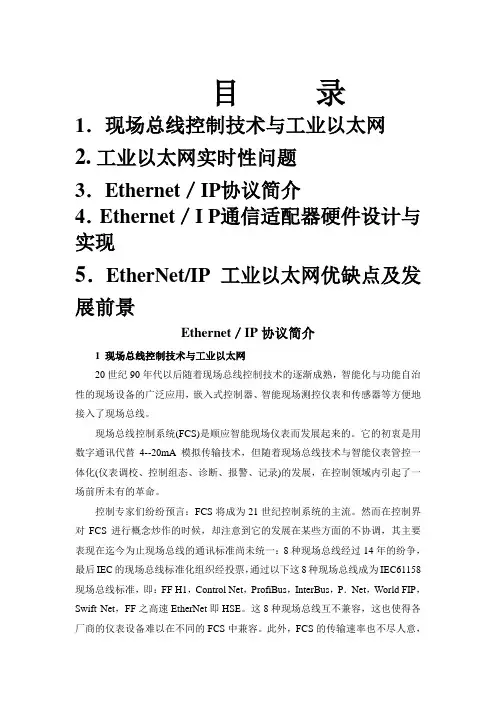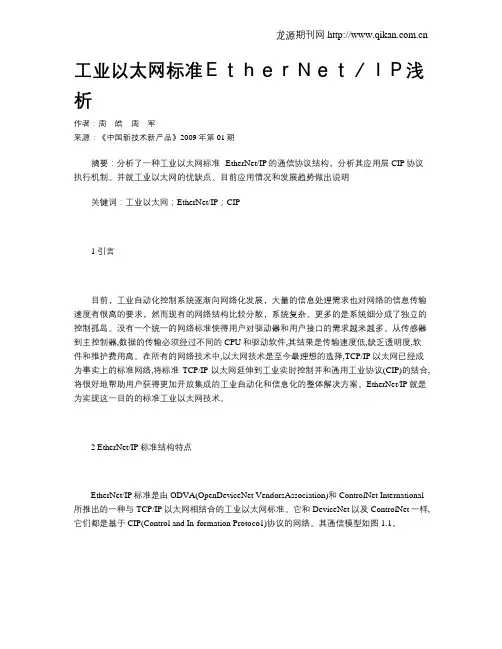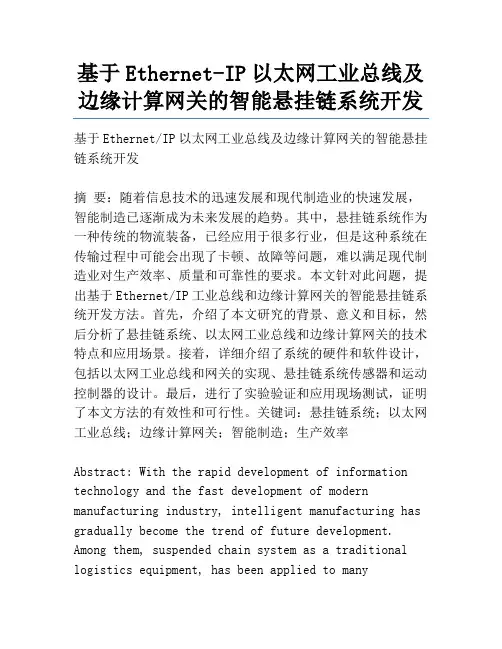EtherNet_IP工业以太网协议白皮书_
克罗韦尔 Logix5000 控制系统中的 EtherNet IP 通信模块 说明书

Logix5000 控制系统中的 EtherNet/IP 通信模块产品目录号 5069-AENTR 、5069-AEN2TR用户手册原版说明书译文重要用户须知在安装、配置、操作或维护本产品之前,请阅读本文档以及“其他资源”章节所列的文档,了解关于安装、配置和操作该设备的信息。
除了所有适用的条例、法律和标准的要求之外,用户还必须熟悉安装和接线说明。
包括安装、调整、投入运行、使用、装配、拆卸和维护等在内操作必须由经过适当培训的人员根据适用的操作守则来执行。
如果未遵照制造商所指定的方式使用该设备,将可能导致该设备提供的保护失效。
对于由于使用或应用此设备而导致的任何间接损失或连带损失,罗克韦尔自动化公司在任何情况下都不承担任何责任。
本手册中包含的示例和图表仅用于说明。
由于任何具体的安装都存在很多差异和要求,罗克韦尔自动化对于依据这些示例和图表所进行的实际应用不承担任何责任和义务。
对于因使用本手册中所述信息、电路、设备或软件而引起的专利问题,罗克韦尔自动化公司不承担任何责任。
未经罗克韦尔自动化公司的书面许可,不得复制本手册的全部或部分内容。
在整本手册中,我们在必要的地方使用了以下注释,来提醒您注意相关的安全事宜。
设备表面或内部的标签提供特定的预防措施。
警告:标识在危险环境下可能导致爆炸,进而导致人员伤亡、物品损坏或经济损失的操作或情况。
注意: 标识可能导致人员伤亡、物品损坏或经济损失的操作或情况。
注意符号有助于您确定危险情况,避免发生危险,并了解可能的后果。
重要事项标识对成功应用和理解产品有重要作用的信息。
电击危险:位于设备 (例如,驱动器或电机) 表面或内部的标签,提醒相关人员可能存在危险电压。
灼伤危险: 位于设备 (例如,驱动器或电机) 表面或内部的标签,提醒相关人员表面可能存在高温危险。
弧闪危险:位于设备 (例如,电机控制中心) 表面或内部的标签,提醒相关人员可能出现闪弧。
闪弧可导致重伤或死亡。
佩戴适当的个人防护设备 (PPE)。
Ethernet/IP协议简介(doc 16页)完美版

目录1.现场总线控制技术与工业以太网2.工业以太网实时性问题3.Ethernet/IP协议简介4.Ethernet/I P通信适配器硬件设计与实现5.EtherNet/IP 工业以太网优缺点及发展前景Ethernet/IP协议简介1 现场总线控制技术与工业以太网20世纪90年代以后随着现场总线控制技术的逐渐成熟,智能化与功能自治性的现场设备的广泛应用,嵌入式控制器、智能现场测控仪表和传感器等方便地接入了现场总线。
现场总线控制系统(FCS)是顺应智能现场仪表而发展起来的。
它的初衷是用数字通讯代替4--20mA模拟传输技术,但随着现场总线技术与智能仪表管控一体化(仪表调校、控制组态、诊断、报警、记录)的发展,在控制领域内引起了一场前所未有的革命。
控制专家们纷纷预言:FCS将成为21世纪控制系统的主流。
然而在控制界对FCS进行概念炒作的时候,却注意到它的发展在某些方面的不协调,其主要表现在迄今为止现场总线的通讯标准尚未统一:8种现场总线经过14年的纷争,最后IEC的现场总线标准化组织经投票,通过以下这8种现场总线成为IEC61158现场总线标准,即:FF H1,Control Net,ProfiBus,InterBus,P.Net,World FIP,Swift Net,FF之高速EtherNet即HSE。
这8种现场总线互不兼容,这也使得各厂商的仪表设备难以在不同的FCS中兼容。
此外,FCS的传输速率也不尽人意,以基金会现场总线(FF)正在制定的国际标准为例,它采用了ISO的参考模型中的3层(物理层、数据链路层和应用层)和极具特色的用户层,其低速总线H1的传输速度为31.25kbps,高速总线H2的传输速度为1 Mbps或2.5Mbps,这在有些场合下仍无法满足实时控制的要求。
又如广泛用于汽车行业的Can总线系统,其最高的传输速率为1 Mbps/40米;这些现场总线受通讯距离制约较大。
由于上述原因,使FCS在工业控制中的推广应用受到了一定的限制。
工业互联网架构白皮书知识考核试题与答案精选全文完整版

可编辑修改精选全文完整版工业互联网架构白皮书知识考核一、不定项选择题1.等保2.0提出的基本原则有()*A.分等级保护√B.突出重点√C.整体防护D.积极防御√E.综合防护√2.2020年5月22日,《2020年国务院政府工作报告》提出,重点支持“两新一重”建设,其中“两新”是指()*A.新型基础设施建设√B.新型城镇化建设√C.新型工业体系建设D.新型互联网+建设3.工业互联网安全体系架构,基于安全需求,从哪些角度出发进行的设计。
()*A.利益相关者√B.垂直行业√C.动态风控D.安全视角√4.工业互联网安全体系架构从安全视角看,可以从哪几个视图来构建工业互联网安全体系。
()*A.安全业务√B.安全功能√C.安全实施√D.安全技术√5.随着工业互联网安全攻击日益呈现出的新型化、多样化、复杂化,现有的工业互联网安全暴露出哪些问题()*A.数据隐私和数据安全防护缺乏有效手段√B.工业生产迭代周期短,存量设备可以快速进行安全防护升级换代C.OT与IT两个领域人员融合较慢,安全意识急需提升√D.工业信息安全存在先天不足,安全防护能力难以快速提升√6.工业互联网安全产业发展趋势为()*A.工业互联网产业政策持续向好√B.融合多领域技术的工业互联网安全解决方案涌现√C.工业互联网安全得到越来重视√D.工业互联网安全标准不断完善与发展√E.工业互联网安全人才需求持续增长√7.下面那项不是企业工业互联网云平台需要解决安全风险或难题()[单选题] *A.云内更多东西访问,边界防护失效B.威胁态势无感知,虚拟层漏洞不易修复C.网络边界消失,硬件设备无法部署D.相较于外部攻击,内部人员攻击不会造成较大风险√8.工业互联网安全技术发展趋势为()*A.工业互联网安全态势监测与感知将成为重要技术手段√B.工业互联网未知威胁防范√C.云平台成为安全防护的重点√D.内生安全防御和补偿式安全防御将长期并存√E.工业互联网安全防护自动化与智能化将不断发展√9.安全业务视图包含的维度有()*A.行业维度√B.企业维度√C.建设维度√D.政府维度E.安全能力√10.建设维度的主要任务是()*A.加强工业互联网安全公共服务能力B.构建工业互联网安全管理体系√C.提升企业工业互联网安全防护水平√D.强化工业互联网数据安全保护能力√11.企业维度的主要任务是()*A.推动工业互联网安全责任落实√B.构建工业互联网安全管理体系C.提升企业工业互联网安全防护水平√D.强化工业互联网数据安全保护能力12.工业互联网主要由工业制造OT系统和信息IT系统构成,IT系统与OT系统存在的不同之处有()*A.传统安全保护的是服务器、个人计算终端,工控安全保护的是工业控制设备√B.不同的工业场景,工控系统的应用方式区别较大,不同的工控系统、以及相同类工控系统但不同厂家设备,都有较大的差别。
以太网技术白皮书

以太网安全技术白皮书摘要本文详细介绍了Quidway系列以太网交换机所应用的安全技术,包括访问控制、802.1X网络访问控制、基于Portal协议的web认证、防地址假冒、入侵检测与防范、安全管理等,并探讨了Quidway系列以太网交换机在安全方面的发展方向。
结合Quidway系列以太网交换机在安全方面的功能特点,给出了在企业网应用中的实际解决方案。
关键词以太网安全,web认证,802.1X网络访问控制1 概述随着以太网应用的日益普及,尤其是在一些大中型企业网的应用,以太网安全成为日益迫切的需求。
一方面以太网交换机作为企业内部网络之间通讯的关键设备,有必要在企业网内部提供充分的安全保护功能。
另一方面用户只要能接入以太网交换机,就可以访问Internet网上的设备或资源,使WLAN上的安全性问题更显突出。
Quidway系列以太网交换机提供了多种网络安全机制包括:访问控制、用户验证、防地址假冒、入侵检测与防范、安全管理等技术。
本文将对其原理与技术实现作介绍。
2 安全交换机的设计原则针对以太网存在的各种安全隐患,安全交换机必须具有如下的安全特性:∙访问控制∙用户验证∙防地址假冒∙入侵检测与防范∙安全管理2.1 访问控制访问控制分为以下几种情况:1、对于交换机的访问控制。
对交换机的访问权限需要进行口令的分级保护。
只有持有相应口令的特权用户才能对交换机进行配置;一般用户只有查看普通信息的权力。
2、基于IP地址的访问控制。
一般情况下,用户(包括网内用户和分支机构、合作伙伴等网外用户)是通过IP地址来区分的,不同的用户具有不同的权限。
通过包过滤实现基于IP地址的访问控制,可以实现对重要资源的保护。
3、基于MAC地址的访问控制。
特殊情况下,用户也可以通过MAC地址来区分。
通过实现基于MAC地址的访问控制,可以保护特殊用户的权限。
4、基于端口的访问控制。
对于接入用户来说,他们之间的权限也有可能是不一样的。
通过对用户接入的端口设置特定的过滤属性,可实现对接入用户的访问控制。
工业以太网标准EtherNet/IP浅析

工业以太网标准EtherNet/IP浅析作者:周皓周军来源:《中国新技术新产品》2009年第01期摘要:分析了一种工业以太网标准--EtherNet/IP的通信协议结构,分析其应用层CIP协议执行机制。
并就工业以太网的优缺点、目前应用情况和发展趋势做出说明关键词:工业以太网;EtherNet/IP;CIP1 引言目前,工业自动化控制系统逐渐向网络化发展,大量的信息处理需求也对网络的信息传输速度有很高的要求,然而现有的网络结构比较分散,系统复杂。
更多的是系统细分成了独立的控制孤岛。
没有一个统一的网络标准使得用户对驱动器和用户接口的需求越来越多。
从传感器到主控制器,数据的传输必须经过不同的CPU和驱动软件,其结果是传输速度低,缺乏透明度,软件和维护费用高。
在所有的网络技术中,以太网技术是至今最理想的选择,TCP/IP以太网已经成为事实上的标准网络,将标准TCP/IP以太网延伸到工业实时控制并和通用工业协议(CIP)的结合,将很好地帮助用户获得更加开放集成的工业自动化和信息化的整体解决方案。
EtherNet/IP就是为实现这一目的的标准工业以太网技术。
2 EtherNet/IP标准结构特点EtherNet/IP标准是由ODVA(OpenDeviceNet VendorsAssociation)和ControlNet International 所推出的一种与TCP/IP以太网相结合的工业以太网标准。
它和DeviceNet以及ControlNet一样,它们都是基于CIP(Control and In-formation Protoco1)协议的网络。
其通信模型如图1.1。
这个模型可以看出,EtherNet/IP工业以太网和DeviceNet现场总线、ControlNet现场总线的不同, EtherNet/IP工业以太网除了采用OSI七层模型中的物理层、数据链路层和应用层之外,还包括了网络层和传输层,并且采用了TCP/IP协议,而DeviceNet现场总线、ControlNet 现场总线只定义了物理层、数据链路层和应用层。
基于Ethernet-IP以太网工业总线及边缘计算网关的智能悬挂链系统开发

基于Ethernet-IP以太网工业总线及边缘计算网关的智能悬挂链系统开发基于Ethernet/IP以太网工业总线及边缘计算网关的智能悬挂链系统开发摘要:随着信息技术的迅速发展和现代制造业的快速发展,智能制造已逐渐成为未来发展的趋势。
其中,悬挂链系统作为一种传统的物流装备,已经应用于很多行业,但是这种系统在传输过程中可能会出现了卡顿、故障等问题,难以满足现代制造业对生产效率、质量和可靠性的要求。
本文针对此问题,提出基于Ethernet/IP工业总线和边缘计算网关的智能悬挂链系统开发方法。
首先,介绍了本文研究的背景、意义和目标,然后分析了悬挂链系统、以太网工业总线和边缘计算网关的技术特点和应用场景。
接着,详细介绍了系统的硬件和软件设计,包括以太网工业总线和网关的实现、悬挂链系统传感器和运动控制器的设计。
最后,进行了实验验证和应用现场测试,证明了本文方法的有效性和可行性。
关键词:悬挂链系统;以太网工业总线;边缘计算网关;智能制造;生产效率Abstract: With the rapid development of information technology and the fast development of modern manufacturing industry, intelligent manufacturing has gradually become the trend of future development. Among them, suspended chain system as a traditional logistics equipment, has been applied to manyindustries. However, this system may have problemssuch as carding and failure during transmission, which is difficult to meet the requirements of modern manufacturing industry for production efficiency, quality and reliability. In this paper, theintelligent suspended chain system development method based on Ethernet/IP industrial bus and edge computing gateway is proposed. Firstly, the background, significance and goal of this paper are introduced,and then the technical characteristics and application scenarios of suspended chain system, Ethernet/IP industrial bus and edge computing gateway are analyzed. Then, the hardware and software design of the system are introduced in detail, including the implementation of Ethernet/IP industrial bus and gateway, and the design of suspended chain system sensor and motion controller. Finally, the experiment is verified and applied on-site test, which proves the effectiveness and feasibility of this paper method. Keywords: suspended chain system; Ethernet/IP industrial bus; edge computing gateway; intelligent manufacturing; production efficiencThe suspended chain system is widely used in the manufacturing industry for its high efficiency and flexibility. However, the traditional manual chain system is unable to cope with the increasing demandfor mass production and intelligent manufacturing. Thus, the development of an intelligent suspendedchain system has become a top priority in the industry.In this paper, we propose an intelligent suspended chain system based on Ethernet/IP industrial bus and edge computing gateway. The system consists of a suspended chain system sensor, a motion controller,and an edge computing gateway. The suspended chain system sensor is responsible for collecting real-time data such as the position, speed, and angle of the chain system. The motion controller receives the data from the sensor and controls the movement of the chain system according to the specified parameters.The system utilizes Ethernet/IP industrial bus as the communication protocol, which provides a high-speed, secure, and reliable data transmission. Furthermore, the edge computing gateway is utilized to performlocal computation, which reduces the latency and enhances the real-time performance of the system.The hardware design of the system includes theselection of sensors, controllers, and the gateway. We use the Allen-Bradley 1769-L33ER programmable logic controller (PLC) as the motion controller, and the EtherWAN EX47018 Ethernet switch as the industrialgateway. The software design includes the development of the PLC program and the gateway program. The PLC program is responsible for processing the data fromthe sensor and controlling the movement of the chain system. The gateway program processes the data fromthe PLC and sends it to the upper-level system for further analysis.Finally, we conducted experiments to verify the effectiveness and feasibility of the proposed method. The experiment was conducted in a real production line, and the results show that the system can achieve high accuracy, reliability, and efficiency in controlling the suspended chain system.In conclusion, the proposed intelligent suspendedchain system based on Ethernet/IP industrial bus and edge computing gateway is a feasible and effective solution for intelligent manufacturing. It provides a high-speed, secure, and reliable data transmission,and enhances the real-time performance of the system. The application of this system can significantly improve the production efficiency and quality of the manufacturing processMoreover, the intelligent suspended chain system can also be integrated with other intelligentmanufacturing systems, such as robotics, automatic inspection, and quality control systems, to further enhance the overall efficiency and quality of the production process. The system can be remotely monitored and controlled, which allows for more flexibility in production scheduling and reduces the need for manual intervention.Further research can focus on optimizing the control algorithms and parameters of the system to achieve better stability, accuracy, and energy efficiency. The integration of advanced sensing technologies, such as machine vision, can also improve the system's ability to detect and respond to changes in the production environment. Finally, the use of artificial intelligence and machine learning algorithms can enhance the system's ability to learn and adapt to new production scenarios, making it more flexible and responsive to changing market demands.In conclusion, the proposed intelligent suspended chain system is a promising solution for intelligent manufacturing, offering high-speed, secure, reliable, and flexible data transmission and real-time control. Its implementation can significantly improve the efficiency and quality of the manufacturing process, and it can be integrated with other intelligentmanufacturing systems to further enhance production performance. With further research and development, the system can become a key enabler of Industry 4.0, helping manufacturers to stay competitive in an increasingly fast-paced and dynamic marketOne of the main advantages of an intelligent manufacturing system is its ability to optimize the entire manufacturing process. From inventory management to assembly, intelligent systems can analyze data in real-time, providing insights that allow for more efficient operations.One example of this is predictive maintenance, which analyzes machine data to predict when a machine will need maintenance before it breaks down. This allows for planned downtime, reducing the risk of unexpected breakdowns that can halt production.Another example is quality control, where intelligent systems can identify defects in finished products before they leave the line. This ensures that customers receive high-quality products, reducing the risk of returns or warranty claims.Intelligent manufacturing systems can also help to minimize waste, whether it be physical waste or timewaste. By continually analyzing data, these systems can identify areas where resources are being used inefficiently, allowing for adjustments to be made to improve efficiency and reduce waste.Furthermore, intelligent manufacturing systems can be connected to other systems throughout the company, such as financial and customer relationship management systems. This allows for even more comprehensive data analysis, providing a more accurate picture of the company's operations and performance.Of course, implementing an intelligent manufacturing system requires significant investment. In addition to the initial cost of the system itself, there may be additional costs associated with integrating the new system with existing systems and processes, as well as training employees to use the new technology.However, the benefits that these systems provide in terms of cost savings, improved efficiency, and increased productivity can ultimately pay for themselves in the long run.In conclusion, intelligent manufacturing systems have the potential to revolutionize the manufacturing industry. With their ability to analyze data in real-time, these systems can optimize every aspect of the manufacturing process, leading to increased efficiency, improved quality, and reduced waste. While there maybe significant costs associated with implementingthese systems, the benefits are well worth the investmentOverall, intelligent manufacturing systems are a game-changer for the manufacturing industry. By utilizing advanced technologies like , IoT, and data analytics, companies can streamline their operations, boost productivity, and stay competitive in the market. Although there may be upfront costs associated with implementing these systems, the long-term benefits in terms of increased efficiency, improved quality, and reduced waste make them a worthwhile investment. As technology continues to evolve, we can expect to see even more advanced intelligent manufacturing systemsin the future, further transforming the way we manufacture goods。
EtherNetIP交换机在工业以太网中的应用
EtherNet/IP交换机在工业以太网中的应用作者:杜勇来源:《硅谷》2012年第24期摘要:介绍EtherNet/IP交换机产品的特点、该类产品在汽车行业的应用以及对EtherNet/IP通信网络所带来的技术革新。
关键词:管理型交换机;双EtherNet/IP接口;全EtherNet/IP应用中图分类号:TP2 文献标识码:A 文章编号:1671-7597(2012)1220123-011 全EtherNet/IP应用的技术瓶颈Ethernet/IP是专门为工业环境设计的应用层协议。
已经有四个国际团体加入到发展和推广这一公开的工业自动化以太网应用层协议,他们包括:开放设备网供应商协会(ODVA)、工业开放以太网协会(IOANA)、国际控制网络(CI)和工业以太网协会(IEA)。
他们的共同目标是向人们展示Ethernet/IP如何提供一个普遍的适合大范围自动化设备的标准。
Ethernet/IP除了可以满足汽车厂对于现场总线的实时性、安全总线以外,相比于其他类型的现场总线,Ethernet/IP在网络拓扑上具备更加灵活、方便的特点。
从传输介质的角度看,Ethernet/IP具有数据传输能力强,可靠性高等特点。
如果Ethernet/IP能够得到全方位推广,即采用全Ethernet/IP的架构组成整个网络,其与现场总线比较所具有的优势自然不言而喻。
然而,采用全以太网对网络中的以太网交换机的负荷提出了很高的要求,如采用星型网络拓扑,而且模块设备布局也受每根从以太网交换机接出的长度限制,即距交换机距离100米以内。
再加上受交换机自身质量和广播风暴等其他因素影响,在传统工业以太网的产品理念与形态当中,全以太网的成熟应用的确很难得到真正实现。
而作为自动化行业品牌向来的领军者AB在最近几年推出了多款针对全以太网应用的产品和技术革新,其中包括与交换机专家Cisco公司合作研制的Stratix8000系列管理型交换机和众多带有双以太网接口的模块及设备。
工业无源光网络技术白皮书
工业无源光网络 PON 2.0 白皮书目录第一章工业PON 2.0 总体架构 (1)1.1工业PON 2.0 整体思路 (1)1.1.1.背景介绍 (1)1.1.2.工业PON 1.0 架构和面临的主要问题 (2)1.1.3.工业PON 2.0 的定义以及解决的问题 (3)1.2工业PON 2.0 总体架构 (4)1.2.1.工业PON 2.0 系统架构 (4)1.2.2.工业PON 2.0 在工业互联网体系中的位置 (5)1.2.3.工业PON 2.0 与工业PON 1.0 之间的关系 (6)第二章集成数据采集功能的工业PON 2.0 网关 (7)2.1背景介绍 (7)2.2需求分析 (7)2.3技术要求 (8)2.4系统架构解析 (9)2.5关键技术 (10)2.5.1.工业现场协议转换和兼容 (10)2.5.2.开放软件平台技术 (12)第三章网络可用性保障 (12)3.1保护倒换 (12)3.2流氓ONU 检测与隔离 (15)第四章工业PON 2.0 智能管理平台 (16)4.1技术现状和背景介绍 (16)4.2技术方案 (17)4.3系统架构解析 (19)4.4关键技术 (20)第五章典型部署应用场景 (21)5.1离散制造行业应用场景 (21)5.1.1.场景特点.................................................... 21 5.1.2.案例介绍. (2)5.2不同网络规模的部署应用场景及案例展示 (2)第六章演进思路 (3)前言推动互联网与工业融合创新,驱动工业网络化、数字化、智能化发展,是我国制造行业未来发展的主流方向,是应对当前发达国家“高端制造回流”与发展中国家“中低端制造分流”对我国制造行业发展影响的有效方案。
工业互联网目前已上升为我国“制造强国”的国家战略,《国务院关于积极推进“互联网+”行动的指导意见》、《工业和信息化部关于贯彻落实<国务院关于积极推进“互联网+”行动的指导意见>的行动计划(2015-2018 年)》等一系列指导性文件提出要坚持以供给侧结构性改革为主线,加快发展数字经济,推动实体经济和数字经济融合发展,推动互联网、大数据、人工智能同实体经济深度融合,做好信息化和工业化深度融合这篇大文章,推动制造业加速向数字化、网络化、智能化发展。
以太网技术白皮书
以太网技术白皮书摘要本文主要介绍以太网技术的基础、原理和应用。
包含以太网基本原理、链路协议、端口应用设计以及以太网交换机等几个方面的内容。
关键字以太网,CSMA/CD,10BASE,100BASE,1000BASE,10GBASE,自动协商,帧格式,二层交换,POE目录摘要 (1)关键字 (1)1以太网概述 (4)1.1IEEE802.3简介 (4)1.1.1物理模型 (4)1.1.2以太网速度 (6)1.2CSMA/CD (7)1.3数据传输 (7)1.3.1并行和串行传输 (7)1.3.2以太网的传输顺序 (9)1.4双工通信 (9)2数据链路层 (10)2.1链路层功能 (10)2.2MAC帧结构 (11)2.3VLAN (13)2.4通信帧截图 (14)2.5MAC控制器 (15)3物理层 (18)3.1物理层功能 (18)3.1.1PCS子层 (19)3.1.2PMA子层 (24)3.1.3PMD子层和介质 (29)3.1.4扰码 (38)3.2物理层芯片 (39)3.2.1PHY的结构和原理 (39)3.2.2PHY的典型端口设计 (42)3.2.3隔离与RJ-45 (43)3.3Link过程 (45)3.3.1Link Monitor (45)3.3.2Link Time (48)4端口技术 (51)4.110/100/1000BASE-T端口 (51)4.1.1自动协商(Auto- Negotiation) (51)4.1.2自动反转(AUTO-MDIX) (56)4.1.3流量控制 (57)4.1.4POE供电 (58)4.1.5EEE功能 (60)4.210GBASE-T/R端口 (62)4.340G/100GBASE-R端口 (63)4.4端口管理 (64)5以太网交换机 (66)5.1以太网交换机结构 (66)5.2二层交换 (68)6参考文献 (69)1以太网概述1.1IEEE802.3简介IEEE802.3是由美国电气与电子工程师协会(Institute of Electrical and Electronics Engineers,IEEE)标准化的一种局域网连接技术(现在很多已经扩展到广域网连接中)。
工业互联网网络连接白皮书介绍
网络互联
7
工厂内网络发展趋势
融合
技术的开放 数据的开放 产业的开放
开放
网络结构的扁平化 控制信息与过程数据共网传输
有线与无线的协同.
8
灵活 友好
支持本质安全供电及数据传输。 广泛适用于大量工业场景,包括短距(<15米)范围
的机器内、车辆底盘、座舱内的设备通信,以及中长 距(最大1000米)范围的建筑控制、电梯控制、过 程控制等。
工厂内网络关键技术-无线技术&定位技术
MulteFire技术运行在免授权频谱,将LTE 的性能优势与Wi-Fi类似的简单性相结合, 提供更好的网络覆盖,更安全的认证机
工业互联网网络连接白皮书介绍
面向未来,构建工业互联网发展基础
1 背景 2 网络连接体系架构 3 网络互联 4 数据互通 5 工业互联网网络部署演进
1
网络是基础
2016年工业互联网产业联盟发布了 《工业互联网体系架构(版本1.0)》
2017年10月30日国务院常务会议通过《深化“互联 网+先进制造业”发展工业互联网的指导意见》
工业PON网络具有以下优点:
支持多种协议的IT和OT设备的统一接入 支持设备的灵活组网 同时满足IT和OT业务的传输需求 能够实现全网可视化管理
13
工厂外网络发展趋势
普遍化
精细化
工厂外网 络服务
灵活化
14
工厂外网络关键技术-企业专线
15
工厂外网络关键技术-移动通信技术
各种新型移动通信技术是工业互联网实现海量信息采集和服务化延伸等业务的重要支撑和保障。
